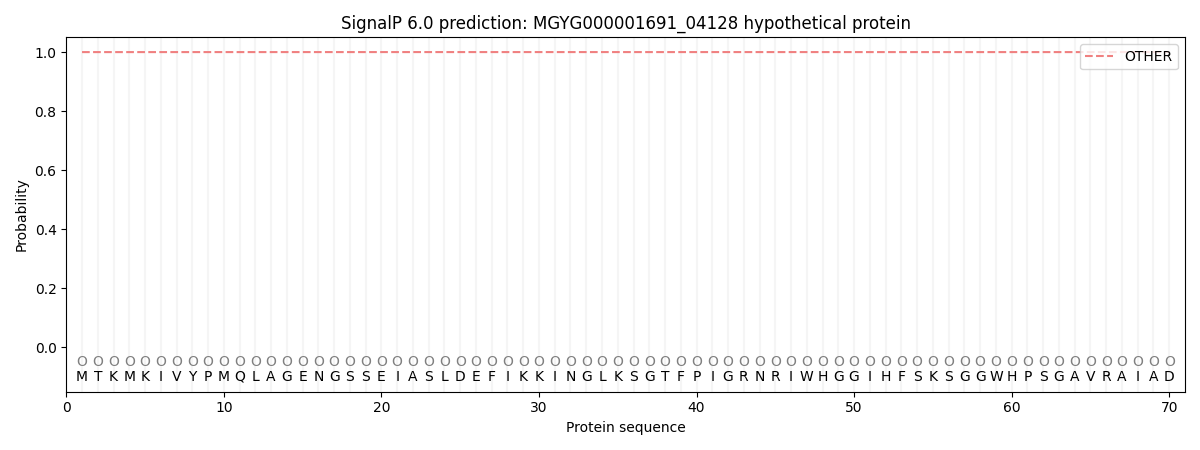You are browsing environment: HUMAN GUT
CAZyme Information: MGYG000001691_04128
You are here: Home > Sequence: MGYG000001691_04128
Basic Information |
Genomic context |
Full Sequence |
Enzyme annotations |
CAZy signature domains |
CDD domains |
CAZyme hits |
PDB hits |
Swiss-Prot hits |
SignalP and Lipop annotations |
TMHMM annotations
Basic Information help
| Species | Aeromonas veronii_A | |||||||||||
|---|---|---|---|---|---|---|---|---|---|---|---|---|
| Lineage | Bacteria; Proteobacteria; Gammaproteobacteria; Enterobacterales; Aeromonadaceae; Aeromonas; Aeromonas veronii_A | |||||||||||
| CAZyme ID | MGYG000001691_04128 | |||||||||||
| CAZy Family | GH19 | |||||||||||
| CAZyme Description | hypothetical protein | |||||||||||
| CAZyme Property |
|
|||||||||||
| Genome Property |
|
|||||||||||
| Gene Location | Start: 743451; End: 746084 Strand: - | |||||||||||
CDD Domains download full data without filtering help
| Cdd ID | Domain | E-Value | qStart | qEnd | sStart | sEnd | Domain Description |
|---|---|---|---|---|---|---|---|
| cd16903 | pesticin_lyz-like | 1.21e-57 | 653 | 821 | 1 | 150 | pesticin C-terminal-like domain of uncharacterized proteins. This subfamily is composed of uncharacterized proteins containing a lysozyme-like domain similar to the C-terminal domain of pesticin. Some members also contain an EF hand domain. Pesticin (Pst) is an anti-bacterial toxin produced by Yersinia pestis that acts through uptake by the target related bacteria and the hydrolysis of peptidoglycan in the periplasm. Pst contains an N-terminal translocation domain, an intermediate receptor binding domain, and a phage-lysozyme like C-terminal activity domain. Bacteriocins such as pesticin are produced by gram-negative bacteria to attack related bacterial stains. Pst is transported to the periplasm via FyuA, an outer-membrane receptor of Y. pestis and E. coli, where it hydrolyzes peptidoglycan via the cleavage of N-acetylmuramic acid and C4 of N-acetylglucosamine. Disruption of the peptidoglycan layer renders the bacteria vulnerable to lysis via osmotic pressure. The pesticin C-terminal domain resembles the lysozyme-like family, which includes soluble lytic transglycosylases (SLT), goose egg-white lysozymes (GEWL), hen egg-white lysozymes (HEWL), chitinases, bacteriophage lambda lysozymes, endolysins, autolysins, and chitosanases. All the members are involved in the hydrolysis of beta-1,4- linked polysaccharides. |
| cd12799 | pesticin_lyz-like | 1.27e-09 | 666 | 821 | 1 | 129 | lysozyme-like C-terminal domain of pesticin and related proteins. Pesticin (Pst) is an anti-bacterial toxin produced by Yersinia pestis that acts through uptake by the target related bacteria and the hydrolysis of peptidoglycan in the periplasm. Pst contains an N-terminal translocation domain, an intermediate receptor binding domain, and a phage-lysozyme like C-terminal activity domain. Bacteriocins such as pesticin are produced by gram-negative bacteria to attack related bacterial stains. Pst is transported to the periplasm via FyuA, an outer-membrane receptor of Y. pestis and E. coli, where it hydrolyzes peptidoglycan via the cleavage of N-acetylmuramic acid and C4 of N-acetylglucosamine. Disruption of the peptidoglycan layer renders the bacteria vulnerable to lysis via osmotic pressure. The pesticin C-terminal domain resembles the lysozyme-like family, which includes soluble lytic transglycosylases (SLT), goose egg-white lysozymes (GEWL), hen egg-white lysozymes (HEWL), chitinases, bacteriophage lambda lysozymes, endolysins, autolysins, and chitosanases. All the members are involved in the hydrolysis of beta-1,4- linked polysaccharides. |
| cd16902 | pesticin_lyz | 8.96e-06 | 675 | 827 | 13 | 139 | lysozyme-like C-terminal domain of pesticin. Pesticin (Pst) is an anti-bacterial toxin produced by Yersinia pestis that acts through uptake by the target related bacteria and the hydrolysis of peptidoglycan in the periplasm. Pst contains an N-terminal translocation domain, an intermediate receptor binding domain, and a phage-lysozyme like C-terminal activity domain. Bacteriocins such as pesticin are produced by gram-negative bacteria to attack related bacterial stains. Pst is transported to the periplasm via FyuA, an outer-membrane receptor of Y. pestis and E. coli, where it hydrolyzes peptidoglycan via the cleavage of N-acetylmuramic acid and C4 of N-acetylglucosamine. Disruption of the peptidoglycan layer renders the bacteria vulnerable to lysis via osmotic pressure. The pesticin C-terminal domain resembles the lysozyme-like family, which includes soluble lytic transglycosylases (SLT), goose egg-white lysozymes (GEWL), hen egg-white lysozymes (HEWL), chitinases, bacteriophage lambda lysozymes, endolysins, autolysins, and chitosanases. All the members are involved in the hydrolysis of beta-1,4- linked polysaccharides. |
CAZyme Hits help
| Hit ID | E-Value | Query Start | Query End | Hit Start | Hit End |
|---|---|---|---|---|---|
| QSR74883.1 | 0.0 | 31 | 641 | 1 | 612 |
| AKA17725.1 | 0.0 | 4 | 649 | 1 | 645 |
| SBT60307.1 | 1.11e-285 | 4 | 641 | 1 | 633 |
| AVQ87085.1 | 1.05e-276 | 4 | 639 | 1 | 631 |
| QOH80403.1 | 2.00e-276 | 4 | 640 | 1 | 632 |
Swiss-Prot Hits help
SignalP and Lipop Annotations help
This protein is predicted as OTHER

| Other | SP_Sec_SPI | LIPO_Sec_SPII | TAT_Tat_SPI | TATLIP_Sec_SPII | PILIN_Sec_SPIII |
|---|---|---|---|---|---|
| 1.000045 | 0.000000 | 0.000000 | 0.000000 | 0.000000 | 0.000000 |
